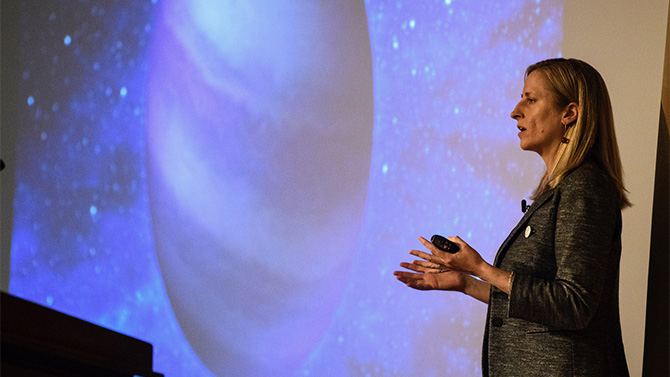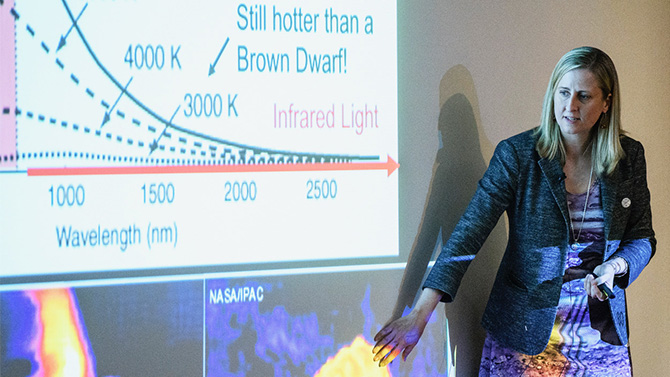

Brown dwarf mysteries
Photos by Kathy F. Atkinson May 02, 2017
Cooling celestial objects heat up curiosity
A few hundred star watchers turned out at the University of Delaware on Thursday evening, April 27. Not to catch a glimpse of Hollywood glamour, but to peer into the mysterious world of brown dwarfs.
Why should we know more about these celestial objects, which are neither stars nor planets? According to Emily Rice, an astronomer at the College of Staten Island, brown dwarfs hold important keys to understanding our universe. They also may help us find a new planet to live on. Eons into the future, as the sun evolves into a red giant star, Earth will be much too hot for life to exist.
Rice, who collaborates on research with faculty in UD’s Department of Physics and Astronomy, presented the Harcourt C. (Ace) Vernon Memorial Lecture. The popular talk is co-sponsored by the Delaware Asteroseismic Research Center at UD, Mount Cuba Astronomical Observatory and Mount Cuba Foundation.
Brown dwarfs are the “tweens” of the universe, classified between stars and planets. Although they form like stars do, inside dense clouds of gas and dust, brown dwarfs aren’t big enough or hot enough to be stars.
“They just don’t have enough mass, ‘enough stuff,’ to be stars and to do the hydrogen fusion that makes a star shine,” Rice explained.
A star must have the amount of mass equivalent to at least 75 Jupiters to sustain hydrogen fusion. Brown dwarfs have a lower mass.
Rice likes to distinguish between brown dwarfs and planets by their formation. Brown dwarfs form like stars do in clouds of collapsing gas and dust, but planets form in the disks around young stars.
Once a brown dwarf forms, it begins to cool. The coolest brown dwarf found so far has the temperature of a lukewarm cup of coffee, Rice said. The cooler it gets, the fainter it gets.
Annie Jump Cannon (1863–1941), the native Delawarean and revered Harvard astronomer after whom UD’s Cannon Hall is named, was a major force in creating the system for classifying celestial objects based on their temperature and density.
Sometimes called “the astronomer’s alphabet,” it reads O-B-A-F-G-K-M, with the hottest, brightest stars at the O end, and the coolest at the M end. This mnemonic helps students remember the order: “Oh, Be A Fine Girl/Guy and Kiss Me.” Remarkably, Cannon manually classified over 350,000 stars using this system.
In Cannon’s day, astronomers didn’t know brown dwarfs existed. In 1963, scientist Shiv S. Kumar theorized that they did. The first brown dwarf discovery in 1994 made it official. Since then, big telescopes such as the W.M. Keck Observatory in Hawaii, with its giant 33-foot-in-diameter mirror, and the Spitzer and WISE infrared space telescopes have brought many more brown dwarfs out of hiding. The bigger the scope, the better to see these cooling objects, which emit most of their light at infrared wavelengths.
The excitement is mounting for NASA’s James Webb infrared space telescope, which is being built now to replace the Hubble. This new scope, expected to launch in October 2018, will travel a million miles into space, far past the moon. A sunshade the size of a tennis court will protect the telescope from the sun.
“The whole thing will get folded up into a rocket, and will have to unfold in space. This is mind-blowing to me,” Rice said.
UD astronomy professor John Gizis is leading a team that will propose science for the Webb telescope. Searching for exoplanets is likely to be high on the agenda. This past February, the world buzzed with excitement when TRAPPIST-1, an ultra-cool dwarf that Gizis first identified when he was a graduate student, was found to have seven possible Earth-like planets orbiting around it.
“See, the most potentially habitable exoplanets have been found around cool stars!” Rice said.
In her quest to bring the universe down to Earth for non-scientists, Rice co-writes the STARtorialist astronomy-themed fashion blog (she wore a dress with a purple brown-dwarf-pattern for her talk). She does “Astronomy on Tap” presentations at bars in New York City, and the brown dwarf mascot she created has a music video on YouTube, plus a Twitter feed.
Rice also encourages citizen scientists to get involved in ongoing research. In Backyard Worlds: Planet 9, you can help scan for new celestial objects at the edges of our solar system, including brown dwarfs or even the sun’s hypothesized ninth planet.
“Brown dwarfs might be the most numerous objects in our galaxy. They are really ubiquitous out there,” Rice said. “So to understand the universe, we can’t leave them out.”
Contact Us
Have a UDaily story idea?
Contact us at ocm@udel.edu
Members of the press
Contact us at 302-831-NEWS or visit the Media Relations website



